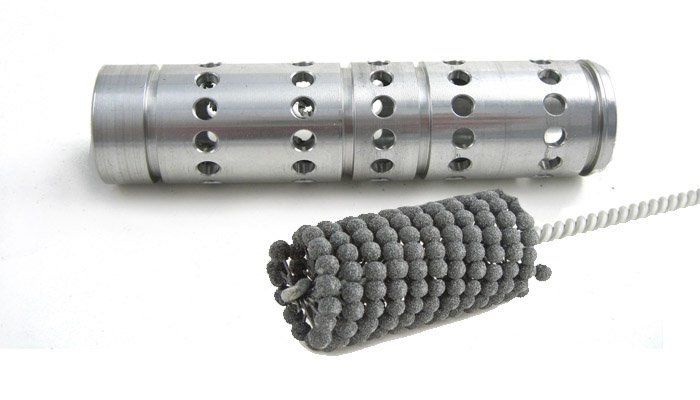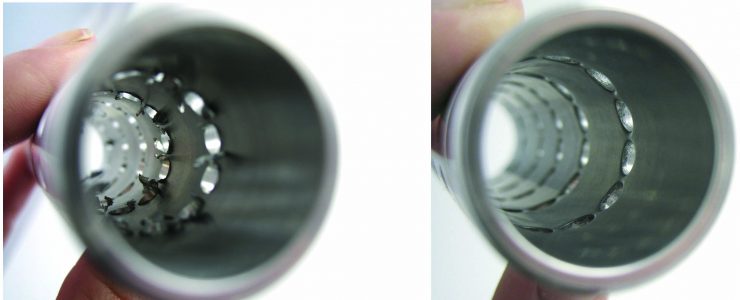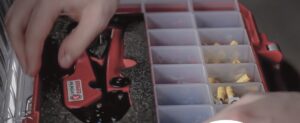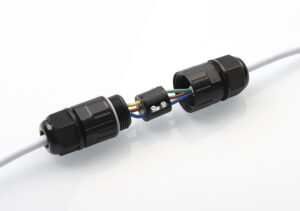
By integrating flexible hones in the machining process, complex parts with cross-drilled holes and other difficult-to-access features can be deburred in house, at less cost.
In automated machining, removal of burrs and sharp edges in cross-drilled holes and other difficult-to-access areas such as undercuts, grooves, slots, or internal holes can be tedious and time consuming. One particular challenge is deburring the intersection of cross-drilled holes frequently found in engine and transmission components.
Despite the challenges, the removal of burrs from the production process is an absolute must for high quality, precision parts. In many applications, cross-drilled holes act as conduits for fluids, lubricants and gases. Failing to remove burrs can cause blockage of these critical passages or create turbulence in the flow. Burrs can also lead to part misalignments, affect dimensional tolerances, and limit the overall efficiency of machined components.
Getting rid of burrs is really important because if there is any loose material that gets dislodged when the product is in use, it can cause major problems.
Although there are many techniques for deburring internal passages at cross-holes, the majority require sending out parts or investing in equipment to complete the work in-house at additional expense.
These options, which include thermal, abrasive flow, electrochemical, and high-pressure water, effectively remove excess material but they also build time into the manufacturing process and add to costs.
The better option, however, for many machining operations is to integrate deburring into the automated process with a simple, effective cross-hole deburring tool such as the Flex-Hone from Brush Research Manufacturing (BRM). By doing so, operators can speed up the manufacturing process and ensure uniform quality for precision parts.
According to Mr Scott, flexible hones are ideal because it is a cost-effective solution to smooth edges and produce a blended radius for cross-hole deburring.
For engineers in the automotive, aerospace, manufacturing and machining industries, the ball-style hone is a highly specialised abrasive tool that is instantly recognisable by its unique appearance.

Characterised by the small, abrasive globules that are permanently mounted to flexible filaments, the product is a flexible, low cost tool utilised for sophisticated surfacing, deburring and edge-blending.
Available in sizes ranging from very small diameter hones (4mm) to those up to 36 inches or more in diameter (a size appropriate for large engine cylinder bores), these deburring tools can be custom designed to the size, shape and abrasive grit to fit any application’s needs.
For best results, the deburring tool is typically rotated into the main bore into which the cross-holes break. After a few clockwise strokes, the tool is removed and the spindle reversed to rotate and stroke the flexible hone in a counter-clockwise direction for a few more strokes.
The forward and reverse rotation creates a symmetrical deburring pattern. Coolant should be used to keep metal cuttings and deburred metal in suspension.
According to Mr Scott, although a flexible hone is often used with automated production equipment it can also be used for secondary deburring options offline as needed.
“The tool can be used in CNC machines and also with a cordless drill,” says Scott. “So, if you manage to deburr 90% of the holes in a machine, but have a few left you can’t access easily, you can use it with a handheld drill and maintain the uniformity in surface finish and process.”
Often additional customisations in a variety of shapes are also possible to meet the requirements of non-traditional applications. This includes spherical-end configurations, stepped or multi-diameter configurations for double diameters and counter-bores, tapered or cone shapes, segmented shapes, or combining globules with other filament materials.
Please contact us for more product details and application solutions.


